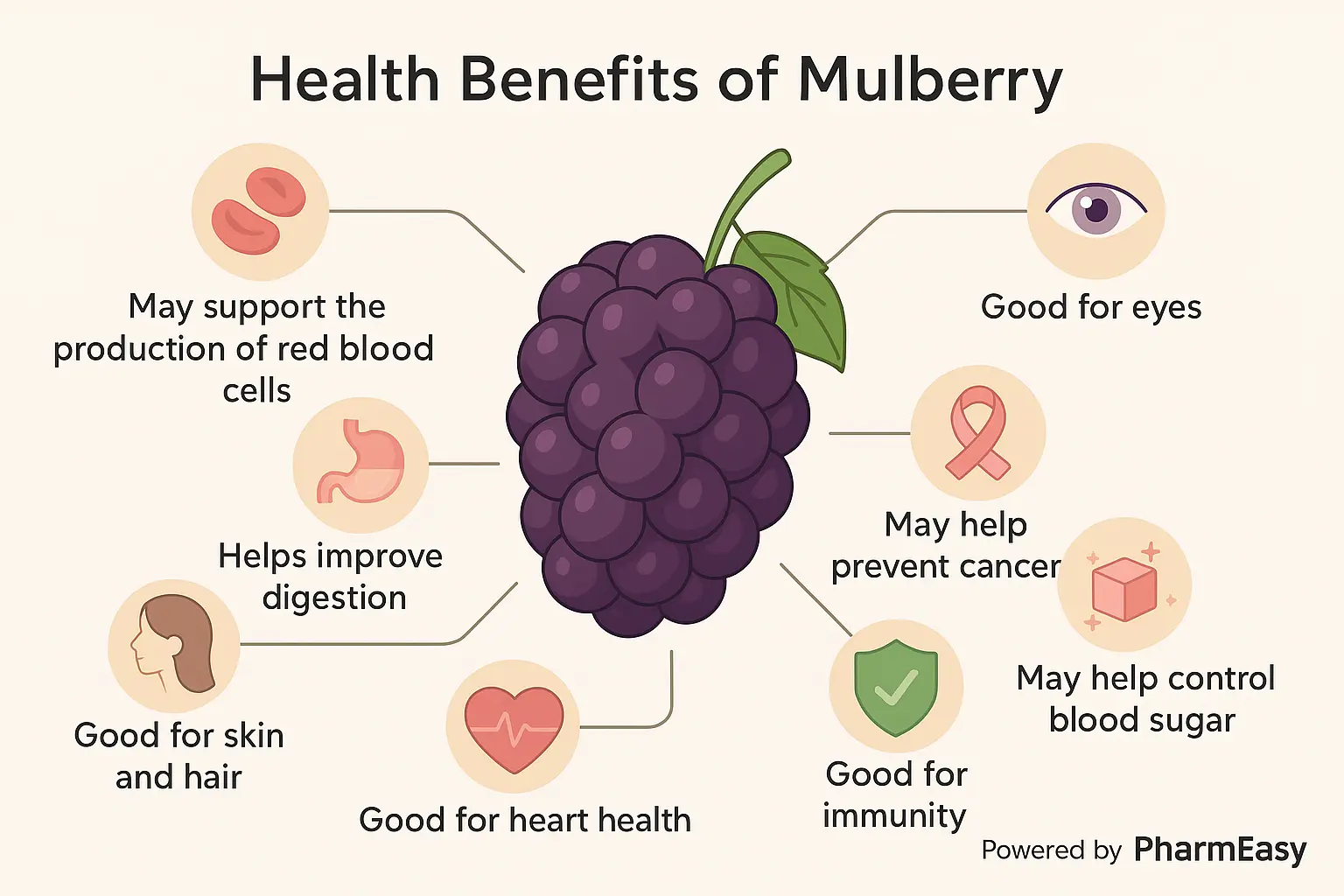Mulberry (Shahtoot): Uses, Benefits, Side Effects and More!
By Dr. Malavika Athavale +2 more

Get,

to manage your symptom
Get your,


4 Cr+ families
benefitted

OTP sent to 9988776655



You’ve successfully subscribed to receive
doctor-approved tips on
Whatsapp

Get ready to feel your best.

Hi There,
Download the PharmEasy App now!!


Register to Avail the Offer
Send OTPBy continuing, you agree with our Privacy Policy and Terms and Conditions

Hi There,
Sign up on PharmEasy now!!
Trusted by 4 crore+ families

OTP sent to 9988776655



You have unlocked 25% off on medicines




Code: NU25
By Dr. Malavika Athavale +2 more
Table of Contents
Mulberry, scientifically known as Morus alba, belongs to the family Morceau. It is considered one of the most significant medicinal plants, valued for its wide-ranging therapeutic uses. The Latin word ‘mor-us’, meaning “oddly enough,” is believed to have influenced the origin of the word “maul.” The genus Morus includes several notable species, such as the native red mulberry (Morus rubra), the East Asian white mulberry (Morus alba), and the southwestern Asian black mulberry (Morus nigra)1,2.
The fruits of mulberry are known as toot or shahtoot (meaning king’s mulberry) are sweet, juicy, and mouth-watering. These fruits grow on deciduous trees found in temperate regions including India, China, Japan, North Africa, Arabia, and Southern Europe. The leaves of the mulberry tree are the sole food source for silkworms and have significant value in the pharmaceutical, cosmetic, and food industries. Owing to its diverse benefits, the tree is often referred to as Kalpavriksha, or the “wish-fulfilling tree”2,3.

Mulberry contains a variety of valuable nutritional components. The fruits are particularly rich in organic compounds such as zeaxanthin, anthocyanins, phytonutrients, lutein, resveratrol, and a broad spectrum of other polyphenolic compounds.
Nutritional value of mulberry (raw fruit) per 100 gram4:
Several studies have found that the extracts from various parts of the mulberry plant may possess a range of properties that could support health and wellbeing, as outlined below2:
From my experience, I can say that mulberries offer remarkable potential benefits. Due to their rich content of vitamin C and iron, mulberries may help support individuals with anaemia by contributing to improved iron absorption and overall blood health. However, their use should always be discussed with a healthcare professional9.
Dr. Siddharth Gupta, B.A.M.S, M.D (Ayu)

Some of the potential benefits of mulberry are described as follows:
Mulberry is rich in iron, a mineral not commonly found in high amounts in most fruits. The presence of iron may support the production of red blood cells, which in turn helps improve the delivery of oxygen to the body’s organs and tissues. This suggests that mulberries might contribute to a healthy metabolism and support the optimal functioning of various bodily systems4.
Mulberries may help to improve digestion as they contain high dietary fibre content. The dietary fibre obtained from a single serving of mulberries is about 1.85 mg for a 100 grams serving4. The dietary fibre in mulberries adds bulk to the stool, which helps to enhance the movement of food through the digestive tract, thereby supporting healthy digestion. This may be beneficial in managing common digestive issues such as stomach cramps, bloating, and constipation3.
Mulberry fruits contain carotenoids, one of which is zea-xanthin. Zea-xanthin acts as an antioxidant and may have potential benefits to maintain retinal health. Free radicals lead to degeneration of the central part of the retina called the macula and may lead to cataracts. Zea-xanthin from mulberry fruits may be able to reduce oxidative stress on the retinal cells due to these free radicals. Thus, it may indicate that mulberry may have the potential to slow down cataract formation3. Further research is needed to evaluate the potential effects of mulberries on cataract development and progression in the human eye.
Mulberry is rich in antioxidants such as vitamin A, vitamin C, anthocyanins, and various other polyphenolic compounds. Antioxidants play a key role in defending the body against free radicals, which are harmful by-products of cellular metabolism. These free radicals can damage healthy cells and may contribute to the mutation of normal cells into cancerous ones. Antioxidants found in mulberries may help neutralise these free radicals, potentially reducing the extent of cellular damage they cause3. Further research is necessary to determine the effects of mulberries on free radicals linked to cancer development.
The extract of mulberry leaves may play a role in catalysing the metabolism of glucose. Animal studies1 have shown that mulberry leaf extract may help lower high blood glucose levels. However, human studies are needed to assess the effects of mulberries on blood glucose levels in people2.
Mulberry is a particularly rich source of vitamin C. Vitamin C contributes to the maintenance of a healthy immune system. A single cup of mulberries can provide approximately the daily recommended amount of vitamin C3. However, any claims regarding the effects of mulberries on immunity require further scientific validation, and their use should be guided by qualified healthcare professionals.
Mulberry fruits contain significant amounts of vitamins A and E, as well as various carotenoids. These compounds act as antioxidants, which may help protect the skin, hair, and other tissues from damage caused by free radicals. Antioxidants are believed to contribute to maintaining a smooth skin appearance and may support healthy, shiny hair. However, further scientific research is needed to confirm these effects, and mulberries should be used as part of a balanced diet rather than as a treatment3. Mulberry may have a role in managing oily or acne-prone skin by potentially reducing oil secretion and inflammation2. However, further research is required to fully understand its potential benefits and safety in humans.
Mulberry leaves contain a flavonoid called resveratrol, which may help relax blood vessels by increasing the production of nitric oxide (NO), a natural vasodilator. This effect could potentially reduce the risk of blood clot formation. While these properties suggest possible cardiovascular benefits, including support for heart health, further research is needed to confirm these effects in humans2,6. However, current studies are insufficient to conclusively establish the effects of mulberries on human heart health, and further research is required to validate these potential benefits.
While some studies suggest potential benefits of mulberries for various conditions, the current evidence is limited. Further research is necessary to establish the full extent of their effects on human health.
I suggest considering mulberry as part of a balanced diet to support weight management. Mulberry may assist in this regard by potentially inhibiting lipid absorption, according to some studies. However, further research is needed to fully understand its effects10.
Dr. Rajeev Singh, BAMS
Mulberry can be used in the following ways5:
You must consult a qualified doctor before taking any herbal supplements. Do not discontinue or replace any prescribed modern medical treatment with Ayurvedic or herbal preparations without medical advice.
Also Read: Kiwi: Uses, Benefits, Side Effects and More!
A few side effects that were observed in studies on consuming mulberry fruit are3:
However, if you experience any adverse reactions to mulberries, immediately contact a doctor as they will be able to guide you appropriately to manage your symptoms.
Here’s a health tip: Mulberry is a natural source of flavonoids, a type of polyphenolic compound, which act as antioxidants. These antioxidants may help protect the body from oxidative damage, potentially playing a role in managing conditions associated with oxidative stress, such as atherosclerosis. Further research is needed to confirm these effects in humans11.
Dr. Smita Barode, B.A.M.S, M.S.
Consuming mulberries in moderate amounts is generally considered safe. However, it is important to follow general precautions when including mulberries in your diet.
Also Read: Chirata: Benefits, Side Effects, Precautions and More!
A clinical study8 suggested that having large amounts of black mulberry juice could interact with drugs that were reported to inhibit cytochrome enzymes; thus it may inhibit the metabolism of various drugs7. Therefore, you must always seek the advice of your Ayurvedic physician and follow their prescription carefully, as they are best placed to consider your health condition and any other medications you may be taking.
Also Read: Blueberries: Uses, Benefits, Side Effects, and More!
Mulberry (Shahtoot) is rich in vitamin A, vitamin E, and carotenoids, all of which are known for their antioxidant properties. These compounds may help support healthy skin by potentially reducing the appearance of scars, age spots, and promoting a smoother, more youthful appearance. Additionally, mulberry leaf extract may be beneficial for individuals with oily or acne-prone skin; however, further studies are needed to confirm these effects in humans.
Various parts and extracts of three major species of the genus Morus may be used, these are:
-Root, stem, leaves, and fruit of Morus alba (white mulberry)
-Root, leaves, and fruits of Morus nigra (black mulberry)
-Root and fruits of Morus rubra (red mulberry).
The immortal mountain wizard tree is a type of tea made from Mulberry leaves. After drying mulberry leaves under the sun, the leaves are brewed to make a tea.
There is no evidence of mulberry fruit or leaf being poisonous. However, one must follow general precautions while taking any herb in large quantities.
Yes, the antioxidants present in mulberry leaf extract may help counter the effects of free radicals that contribute to oxidative damage in hair. This could support the maintenance of healthy, shiny hair. However, further research is required to confirm these potential benefits in humans.
Disclaimer: The information provided here is for educational/awareness purposes only and is not intended to be a substitute for medical treatment by a healthcare professional and should not be relied upon to diagnose or treat any medical condition. The reader should consult a registered medical practitioner to determine the appropriateness of the information and before consuming any medication. PharmEasy does not provide any guarantee or warranty (express or implied) regarding the accuracy, adequacy, completeness, legality, reliability or usefulness of the information; and disclaims any liability arising thereof.
Comments

Leave your comment...
You may also like
Comments